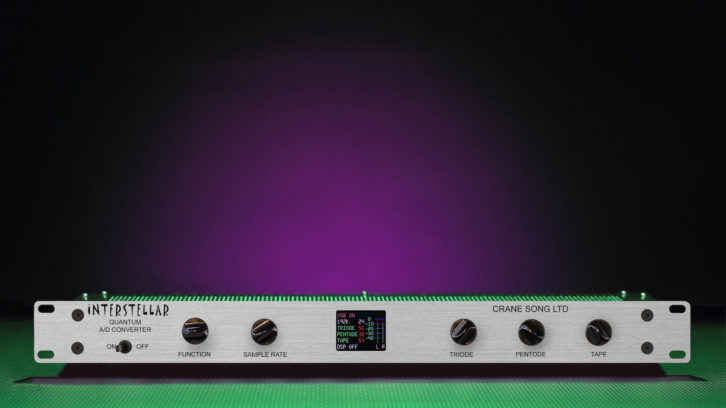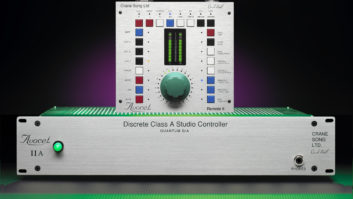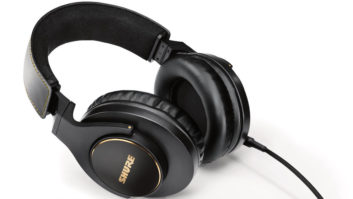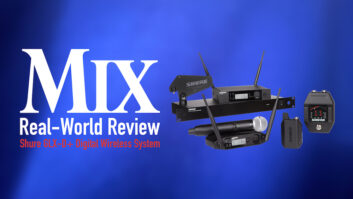
Setting aside musical tastes, recording engineering and production skills for the moment, the most important element in achieving the best possible digital recording is the crucial step of analog-to-digital conversion. That initial A/D process and everything about it defines how “true to the source” the digitized audio can be. A stable word clock with minimal jitter and low phase noise, the choice of sample rate and the analog-to-digital chipset will ensure the best possible sonic outcome. Designer Dave Hill’s new Crane Song Interstellar is the analog-to- digital converter half of the Crane Song HEDD Quantum A/D/D/A converter. It uses the same AKM chipset and the same Quantum word clock technology, with clock signal jitter measuring less than 1-picosecond (10-12 seconds; i.e., the clock varies only about 1 trillionth of a second, near the measurement limit of modern equipment).
In digital audio, fluctuation and instability of the clock signal timing (time domain) and the exact frequency (frequency domain) that causes phase noise is collectively called jitter. Low jitter is important for accurate, true-to-the-source A/D and D/A conversions, but jitter is easily compromised in digital systems.
Jitter in digital audio—which can be caused by inferior master clock design or the improper transmission of the clock signal to equipment throughout the studio—is heard as an increased noise floor, muddiness, lack of or rounded-off transients, harsh high frequencies, and blurred stereo imaging. High amounts of jitter can cause momentary, small pitch changes.
FRONT AND BACK
The 1U Interstellar has a front panel with an on/off toggle power switch and five continuous rotary controllers labeled Function, Sample Rate, Triode, Pentode and Tape. A small color LCD screen mounted in the center of the panel monitors and enables control and setting parameters.
The unit’s Function control rotates between USB off/on, DSP on/off and Setup modes, where either Filter 1 or 2 can be selected. Filter 1 and 2 are choices within the AKM A/D conversion processor chips. The (default) Filter 1 allows for accurate transients and sounds more dynamic and three-dimensional. Filter 2 is flatter-sounding and brighter.
In Setup, you can select either 24-bit (without dither) or dithered 16-bit. In 16-bit dither mode, Dave Hill adds a proprietary pre-dither analog process before the A/D converter.
The Sample Rate controller knob cycles through sample rates of 44.1, 48, 88.2, 96, 176.4 and 192 kHz. You can change the rate at any time, and you don’t have to be in Setup mode.
The next three rotary controllers are separate controls for the Triode, Pentode and Tape processors. Their values are indicated in the LCD window and retained when the unit is powered off.
Connections on the Interstellar’s rear panel include an AES/ EBU XLR digital output, as well as S/PDIF RCA and Optical TOSLINK output jacks. All outputs are always active and available for connection to digital inputs on your audio interface.
Interstellar expands its utility over the full Crane Song HEDD Quantum A/D/D/A with the addition of a rear-panel USB port as a direct interface to any DAW computer. In USB mode, the sample rate is dictated by the DAW session, and you may simultaneously record the same audio into two different systems at the same time if the sample rates all match.
Finally, there is a pair of XLR sockets for balanced stereo line level audio input. They come factory-set for +20 dBu analog input, but you may recalibrate them using the recessed trim pots.
The rear panel has eight Word Clock BNC outputs (two more than the HEDD Quantum), and that is more than enough for a Star configuration. Star is a method of sending individual Word Clock signals around the studio—aka, “house sync”—that originated in video/film post houses to assure all digital devices (tape decks, switchers, etc.) were locked together using SMPTE code and/or WC.
BUILD QUALITY—A LOOK INSIDE
Interstellar is future-proof, with a layout of modular sub-assemblies that plug into a motherboard that uses surface-mount technology throughout. If a new, improved A/D converter becomes available, only that subassembly is changed.
A small switch-mode power supply feeds a total of 18 separate voltage regulators to generate as pure as possible the DC voltages required for all the electronics—especially the sensitive clock boards.
There is only one ribbon cable to connect the front-panel controls to the motherboard, and the entire rear panel and connectors attach directly to the motherboard itself. Notably, the eight BNC Word Clock connectors are each on their own board if one should fail.
Universal Audio Spark – A Real-World Review
The ADC board uses an AKM chipset and plugs into the motherboard. Interstellar has two, baseband master crystal oscillator boards encased in shielded modules. For 44.1, 88.2 and 176.4 kHz clock rates, there is an oscillator running at 22.5792 MHz. For 48, 96 and 192 kHz rates, there is a second oscillator board running at 24.576 MHz. Deriving clock frequencies in this way is said to produce much less phase noise and (therefore) lower jitter than using a Rubidium-based, aka atomic, clock.
At Crane Song, the two oscillator boards are extensively tested and burned in running inside the unit, as well as separately outside of it. In my outboard rack, Interstellar runs slightly warm by design and requires about 20 minutes warmup time to achieve optimum stability.
TRIODE, PENTODE AND TAPE
Triode, Pentode and Tape add analog amplifier-like harmonic richness to the A/D conversion. They are controlled using three separate continuous encoders, with their (0 to 99) numeric values indicated on the LCD screen. They are connected in series, beginning with Triode, and interact with each other.
The Triode function offers triode tube even-ordered harmonics. Of the three, Triode is the subtlest effect, but you will notice (depending on the source) that the low frequencies become fatter and denser with increasing amounts of Triode. I liked it on pianos and some synths—it adds a sweet, unique sound.
Pentode generates mostly third-order and higher odd harmonics. I noticed a brighter sound, with detail and transients more “hearable” and a slight compression effect. I found Pentode great for vocals, percussion (drums) and full mixes.
Tape emulates a tape deck, with odd harmonics starting with third and fifth, plus adds the effect of a tape recorder’s Record and Playback electronics. Completely level-dependent and just like with analog tape, you can hear compression of the high frequencies before the low frequencies. I noticed signal peaks started to flatten out for a higher average level. Cranking up Pentode and Tape does increase overall level, and I found using these new tools to be secret weapons when recording specific instruments and vocals.
IN THE STUDIO
I run a two-card Pro Tools Ultimate HDX system with five I/O boxes, including an Eventide H9000R with its Pro Tools interface card connected to my second HDX card. That is a total of 96 channels of I/O, including 32 analog channels, feeding an SSL Sigma summing box.
When mixing, using the Interstellar ADC with its Word Clock clocking all interfaces, I record the Sigma’s stereo analog output back into Pro Tools in real time for archival and editing—mix iterations are playlisted. When overdubbing, I can route a stereo analog recording chain (mic pre, EQ, compressor) to the Interstellar’s input using a SSL X-Patch 16×16 Matrix Patch Bay.
I ran five separate 75-ohm (RG-59U) WC BNC clock cables coming from Interstellar to each one of the Avid I/O boxes and my H9000R. I use 75-ohm termination resistors at the end of each of the clock cables—the H9K has its own termination built-in. For stereo playback, I’m connecting the XLR AES/EBU digital output (Enclosure) from my last I/O box to my Crane Song Avocet IIA monitor controller with its built-in 32-bit DAC. The Interstellar’s AES/EBU XLR digital output connects to the same I/O box as a stereo digital input.
NO COMPARISON
I am thrilled with both the change to a Star configuration from Avid’s Loop Sync clocking and the sound of Interstellar’s A/D conversion. Those two changes breathed new life into my Pro Tools system and upped the quality of my mix work and all future recordings. Multitrack mix sessions sound amazingly open, with clarified stereo width and a solid sound stage; panned positioning locked in as compared to playing those same sessions using the old Loop Sync setup.
Recording new audio with Interstellar is marvelous. The small VU meters in the LCD display immediately show peaks, and now I can add a certain “je ne sais quoi” analog color to the recording as I see fit. I’m still getting used to the world of HEDD processing, but when unsure, I can always just bypass it and deal with it later.
I started with recording a bass guitar and using the Tape processor set to 60. I was at 48 kHz using Filter 1 and noticed some compression—I liked that I got the sound of hitting analog tape hot and hearing the change right away; without having to actually play back a tape recorder! I used a Retro Instruments Revolver Dual compressor with one channel on the direct signal and the other on the microphone on the amp.
I recorded vocals using the Pentode processor, and it worked great to brighten and slightly compress my singer, who has a dark quality and sings quietly. The Pentode’s brightness is different from equalization and, in this case, was a big winner!
When mixing using the Sigma and Interstellar’s ADC and clock, balances come together much faster and easier. The bottom end of the mix—bass instrument, kicks, low strings—is much clearer and more defined. It was one of the first things I noticed when switching to Star clocking.
INTERSTELLAR SUPERNOVA
Interstellar is irresistible to me! It immediately improves the sound of any digital recording studio in two significant ways: The superlow jitter clock and built-in sonic choices of analog processing from a multi-functional A/D converter. This winner is now at the top of my outboard rack! If you can, you should try one out. Highly recommended.







